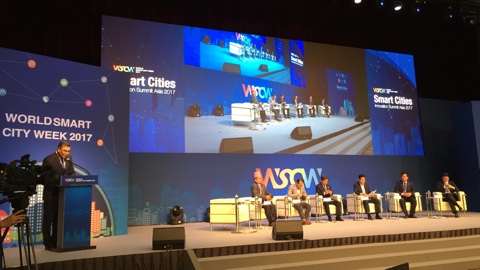
While the last 50 years have represented incredible technological growth around the world, possibly none have sprinted forward more than South Korea. Not only did the country literally rise from the ashes of the Korean War, but it has gone a step further to become a world leader among developing nations, demonstrating that smartness can begin anywhere.
Over the last 40 years, Korea developed 516 new towns. Vice President of the Smart City Division for the Korea Land and Housing Corporation Hyun-Tae Cho attributes much of its upward trajectory to the complementary relationship between economic growth and urbanization. South Korea’s urbanization has far outpaced other countries’, and it has also seen tremendous economic development in those urban centers.
At World Smart City Week, co-located with the Smart Cities Innovation Summit Asia, leaders of South Korean ministries and mayors of the country’s most innovative cities spoke about their strategic vision. They seem to agree on the goal of a unified smart nation.
Goyang City, founder and host of the event boasts first place in the World e-Government (WeGO) Awards and is the self-proclaimed Silicon Valley of Korea. To date, they have improved the lives of citizens in the lake park area by analyzing and monitoring the water quality of fountains, providing environmental insights through installed smart security lights, and using reactive cognition to search for missing children. The city uses historical data on illegal parking for habitual areas so that it can better monitor them. By using dynamic collection routes and schedules, the efficiency of waste collection and management is greatly improved. Not only are costs and labor reduced, but public cleanliness is increased. The government shares public information on an open portal for the benefit of citizens. Among other things, they’re working on a youth smart town with smart residences and smart transit; a living lab; and a smart city index.
The city of Gimhae, though relatively new, boasts 2500 CCTV cameras for transportation communication in real time and an IoT parking system. They have 20 billion Won invested in six major projects including developing solar energy reliance, regeneration of the downtown area, and medical device convergence.
Siheung, just 30 minutes from the capital Seoul, introduced a ubiquitous road map in 2010, a development plan from 2011-2013, and established a smart city framework between 2014-2017.
You’re probably thinking, “how is all of this possible;” and if you are, you’re not alone. Nothing short of a focused, unified government could have surpassed so many milestones in such a short time. “Politically, more democratic countries are adopting a bottom-up approach. However, countries with weaker economies begin with a top-down approach. Korea is now trying to make the transition,” said Dae-Yeon Cho, executive director of the Board of Smart City, Korea Agency for Infrastructure Technology Advancement (KAIA). “We want to reflect the city sentiment and hear the voice of residents.”
Don’t underestimate the small but mighty South Korea. Fifty years after the Korean War, the country is thriving in an age of urbanization and hasn’t forgotten what it took to arrive. With the spirit to overcome and a willingness to share, South Korea quickly leaps toward its place as a leader among smart nations.


